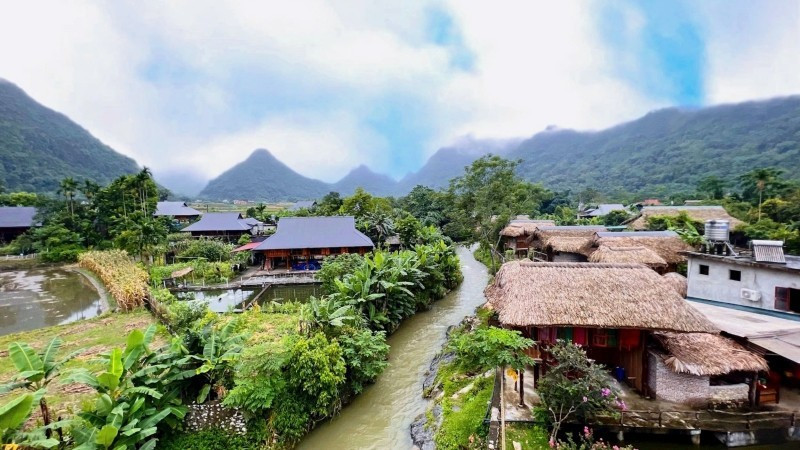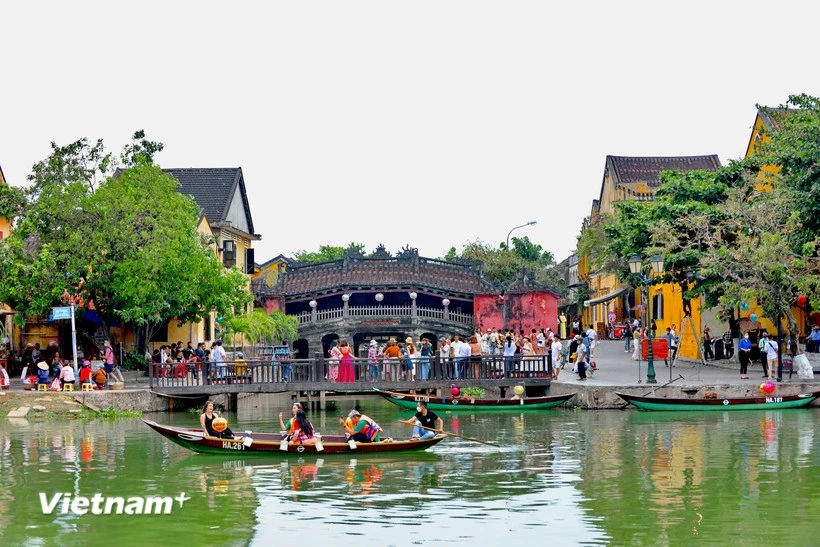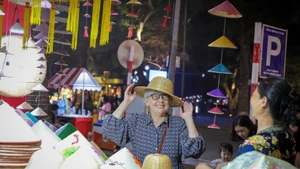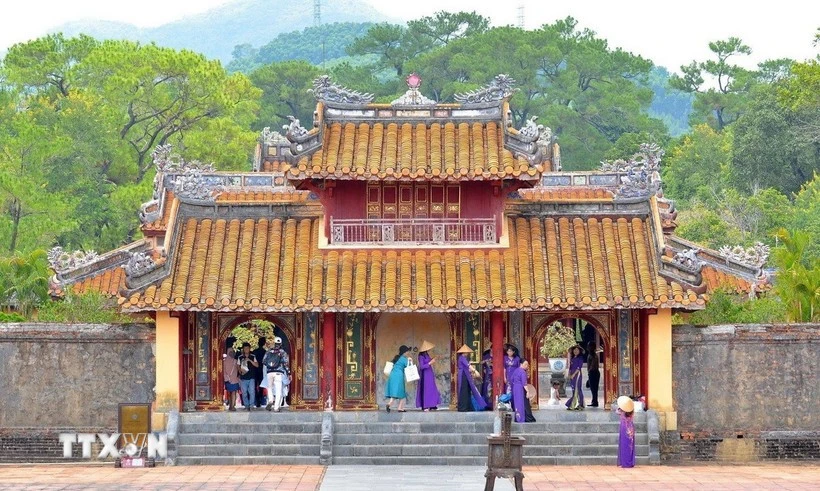One example of this young generation is Hoang Thi Xoi – a 33-year-old Tay woman, who travelled far to study and later returned to her childhood home to start a business, connecting the community to engage in sustainable tourism while honouring agricultural values and local culture.
Preserving the flow of Tay culture
After about 5 hours’ drive from Ha Noi, we arrived at Xoi Farmstay in Tong Pinh Cai Village in Lam Thuong Commune on a day in June. The homestay owner Hoang Thi Xoi was welcoming guests with a broad smile while supervising the construction of a new building.
The stilt house space here is simple yet meticulous: clean tables and chairs, tea and water at the ready, every corner adorned with flowers growing around the garden.
The fatigue from the long journey seemed to vanish immediately when Xoi’s mother and younger sibling laid out a spread with all rustic dishes of the Tay people.
The Tay women in traditional costume look graceful, though their everyday attire is quite simple, consisting merely of colourful short-sleeved tops and plain skirts convenient for labour.
However, I also saw them wearing ceremonial dress in beautiful framed photographs hanging on the house walls. These were hand-woven indigo-dyed long tunics, head scarves, and gleaming silver jewellery - all handcrafted and passed down through generations.
What awakened us in the heart of Lam Thuong Valley wasn’t an alarm clock, but the sound of streams and birdsong. Beside the stilt house veranda, the Khuoi Noi stream murmured as it meandered along the foot of the hill.
In the Tay language, “khuoi” means stream and “noi” means small, to distinguish it from Khuoi Luong - the larger stream. The two waterways meet, forming the source that nourishes the village.
Along with other tourists, I cycled across rice fields, stopped by a lake of blooming pink lotus flowers, then paused for a refreshing dip beneath Nam Chan waterfall during the flowing water season.
Summer here is like a symphony of trickling water, droning cicadas, and children’s voices calling out as they play. The cycling path winds through the villages of Tong Pinh Cai, Tong Pang, Kheo Leng and others, leading visitors along rice paddies, banana groves, vegetable gardens, lotus ponds, interspersed with ancient stilt houses and green maize fields.
Alongside the vibrant nature, culture is the core value. Each place name carries meaning: Tong Pinh Cai means “flat field of lychee trees”, Tong Pang means “field of pang trees” - naming conventions tied to the original vegetation when the Tay ancestors cleared the wilderness to establish settlements, creating a truly vivid memory map.
About four in five households here still maintain traditional wooden stilt houses, with each home having a fish pond and trees in front. Some houses have been renovated with metal roofs and upgraded amenities while preserving the original structure.
One could say that the scenery here is not just aesthetically pleasing but also serves as a valuable resource, a form of “shareable identity”. It’s present in the way food is arranged, in the way locals greet each other and passing visitors. Children grow up amidst nature, growing vegetables, hearing folk tales, studying English, and learning to play the dan tinh, a type of gourd lute. One of the most beloved experiences is making Tay conical hats.
Artisan Hoang Thi Hue from Tong Pang Village, who once worried her craft would fade away, is now busy guiding tourists in weaving frames, attaching palm leaves, and meticulously sewing brocade straps.
The leaf conical hat is no longer just a tool for sun and rain protection, but also a souvenir, performance prop, and decorative item carrying indigenous spirit.
Visitors come here not just to rest, but to live alongside the villagers. They cycle to explore, join locals in rice harvesting, venture into forests to pick vegetables, listen to then singing beneath stilt house roofs, learn to make Tay conical hats, craft wooden flower vases.
Hue said: “In the past, we made conical hats just to wear, and now finds great joy in making them for tourists. Tay conical hats have become countryside gifts that travel to so many distant places.”
Lam Thuong is gradually becoming a destination sought after by many tourists from major domestic cities and international visitors. Not with fanfare or crowds, the genuine beauty of the village and its people is spreading quietly.
In autumn, Lam Thuong dons a golden coat of ripening rice amidst the green of mountains and forests. When winter arrives, mist hangs ethereally, and the village resembles an ink wash painting, where the breath of mountains and forests permeates every indigo-dyed garment of the Tay people, every palm-thatched stilt house roof as beautiful as a fairy tale. Nam Chan and Na Ken waterfalls cascade in white torrents, Tham Duong and Bo Kheo caves invite tourists to explore.
Living amongst the locals, each evening tourists are invited to cultural performances featuring then singing, dan tinh playing, conical hat dancing, and scarf dancing. During festivals, the entire village gathers to celebrate, lighting campfires and telling old stories. The children are excited and the elders are moved to tears when their ethnic culture is not only preserved but also cherished and spread further each day.
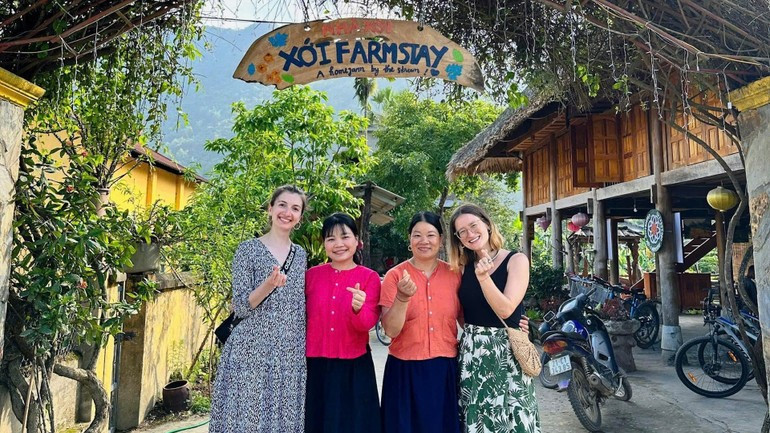
The village’s green shoots
According to Hoang Duy Than, head of Tong Pinh Cai Village, Xoi’s farmstay is a pioneering community tourism development model in the locality, contributing to job creation for locals and actively promoting the village’s image and Tay culture.
“Ms Xoi is an exemplary model of studious young people who return to Tong Pinh Cai to enrich their homeland. She conducts community tourism very systematically and also guides and motivates many other families in the area to develop their economy through tourism,” Than said.
Hoang Thi Xoi was born and raised in Tong Pinh Cai Village, loved and excelled in foreign languages, so she studied tourism and became a guide for international visitors.
After travelling extensively both domestically and internationally, one day Xoi returned home with 50 million VND (1,900 USD) as capital, renovating her family’s old stilt house into a guest accommodation.
At first, no one believed that a remote area like Lam Thuong, considered a dead end, would attract visitors. But Xoi recognised and valued what few people noticed: the small stream bubbling year-round, waterfalls cascading through ancient forests, the peaceful picturesque village, and a treasury of Tay culture that needed to be told properly. The young woman taught herself and did everything from scratch, from house design to learning farmstay models everywhere, promoting on social media.
“I even made my own leaflets and asked to display them in restaurants in Ha Noi’s Old Quarter, hoping they would reach as many people as possible,” Xoi recounted.
From a single shared stilt house in 2017, Xoi Farmstay has now expanded to five separate stilt houses, one spacious communal building, with a capacity for up to 50 guests per day, creating employment for 20 local workers, with dozens of others benefiting from catering services, trekking, handicraft workshops.
On Google, Xoi Farmstay achieves a 4.9/5 rating and on Booking.com it’s 9.8/10, figures that any tourism establishment in the digital age would dream of. What makes visitors remember forever is not just the beautiful scenery but also the warm hospitality.
And Xoi isn’t alone. Other models like Moc Farmstay in Kheo Leng Village, Jack Ecolodge by young man Hoang Trong Giac, Hoang Thi Sinh’s family in Chang Pong Village, Tang Viet Dung’s family in Nam Chan Village have formed successively.
Each person has their own approach, but they share the same spirit of preserving culture and conducting honest tourism. No one doubts anymore “What’s here to do tourism with?”. Locals in the area are now accustomed to meeting international visitors, some know English, some have opened coffee shops, but without losing their authenticity and friendliness.
During the off-peak season, Xoi Farmstay doesn’t waste resources. Xoi joins with mothers and sisters in the village to sell local agricultural products through livestreaming. She also connects with young people from other rural areas, those who also left the city to return to forests and seas to research and make products tied to their homeland’s advantages. To ensure tourism closely links with agriculture and creates sustainable direction, they become a network supporting each other, creating a green startup community.
The story of Hoang Thi Xoi in Lam Thuong brings to mind the family of Vang Thi Thong in Lien Village (Bac Ha, Lao Cai). This land recently created an exploration fever through the reality TV show “Haha Family”, when many famous entertainers came to eat, stay and work alongside the locals.
Both places prove that in an increasingly digitised and developed society, identity is always the most precious asset, without the need for embellishment.
Then singing and dan tinh playing, festivals, handcrafted costumes are still present in daily life and especially more beautiful when visitors come to visit.
What’s worth cherishing is that tourism here does not follow the masses, does not become laden with concrete structures. The forest remains green, streams remain clear, rice fields still ripen golden at the foot of mountains. Identity exists completely in every house, lifestyle, song and grain of rice.
